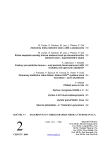Femoral neck fractures in children and adolescents
Authors:
Marcel Guřan; Stanislav Čambor; Miroslav Lisý; Ladislav Plánka; Petr Gál
Authors‘ workplace:
Clinic of Pediatric Surgery, Orthopedics and Traumatology, the Faculty Hospital Brno, Czech Republic
; Klinika dětské chirurgie, ortopedie a traumatologie FN Brno
; Department of Traumatology, Tomas Baťa Regional Hospital Zlín, Czech Republic
; Traumatologické oddělení Krajské nemocnice Tomáše Bati Zlín
Published in:
Úraz chir. 17., 2009, č.2
Overview
Objective:
Our study presents treatment results of proximal femoral fractures dealt with at KDCHOT FN Brno and KNTB over a period of 12 years (1997–2008). We focused on the therapy results and the development of postoperative complications in particular. The final outcome of our study is based on examination of the selected procedure in terms of its standard application in this type of injury. The standard procedure is considered helpful in case of diagnostic and therapeutic doubt resulting from low incidence.
Materials and methods:
The primary sources included information on injury mechanism and first treatment. In addition to the selected procedure, the interval between injury and first treatment was considered. In the next stage, we monitored clinical treatment results (range of hip joint movement, patient’s own assessment), X-ray examination results and the occurrence of complications. Our aim was to provide an over-view of the applied methods and their therapeutic results and also to find a statistically significant relation between the incidence of avascular necrosis and the time of first treatment, the injury type based on the Delbet-Collona classification and the patient age.
Results:
A statistically significant relation of the interval between injury and first treatment to the incidence of avascular necrosis was proved. Avascular necrosis was found to develop in patients with surgical treatment 14 and more hours after injury. A statistically significant relation was also established between the injury type based on the Delbet-Collona classification and avascular necrosis incidence. Necrosis did not occur in type IV and the highest incidence was found in type II. A statistically significant relation between necrosis incidence and the patient age was not proved in our data set.
Conclusion:
Out of the total of 48 patients, 73 % exhibited healing without subsequent complications. On the whole, avascular necrosis incidence was low (16%) and so was the occurrence of coxa vara (13%). The occurrence of other complications was rather scarce.
Key wordsp:
pproximal femur, avascular necrosis, child, osteosynthesis.
Sources
1. El-Sayed, M., Abulsaad. M., El-Hadidi, M. et al. Reconstruction plate fixation of subtrochanteric femoral fractures in children. Acta Orthop Belg. 2007, 73, 484–490.
2. Gordon, J.E., Khanna, N., Luhmann, S.J. et al. Intramedullary nailing of femoral fractures in children through the lateral aspect of the greater tro-chanter using a modified rigid humeral intramedullary nail: preliminary results of a new technique in 15 chil-dren. J Orthop Trauma. 2004, 18, 416–422.
3. Graves, R.M., Sands, K.C. Avascular necrosis of the femoral head following intramedullary nailing of the femur in a skeletally mature young adult: a case report. Am J Orthop. 2008, 37, 523.
4. Havránek, P., Staudacherová, I., Hájko-vá, H. Proximal femoral fractures in children. Acta Univ Carol. 1989, 35, 223–242.
5. Hughes, L.O., Beaty, J.H. Current concepts review: fractures of the head end neck of the femur in children. J Bone Joint Surg. 1994, 76-Am, 283–292.
6. Lipczyk, Z., Niedzielski, K., Kraska, T. Fracture of the femoral neck in children. Chir Narzadow Ruchu Ortop Pol. 2007, 72, 19–24.
7. Lorczyński, A., Kozdryk, J. Long term results of femoral neck fractures in children. Chir Narzadow Ruchu Ortop Pol. 2007, 72, 259–263.
8. Matejka, J., Pavelka, T., Kostál, J., Cer-venková, H. Long-term results following fracture of the femoral neck in children. Acta Chir Orthop Traumatol Cech. 2005, 72, 98–104.
9. Maruenda, J.I., Barrios, C., Gomar-San-cho, F. Intracapsular hip pressure after femoral neck fracture. Clin Orthop Rel Res. 1997, 340, 172–180.
10. Mayr, J., Hirner, V., Styhler, W. et al. Femoral neck fractures in childhood. Unfallchirurgie 1998, 101, 426–432.
11. Moon, E.S., Mehlman, C.T. Risk factors for avascular necrosis after femoral neck fractures in chil-dren: 25 Cincinnati cases and meta-analysis of 360 cases. J Orthop Trauma. 2006, 20, 323–329.
12. Ng, G.P., Cole, W.G. Effect of early hip decom-pression on the frequency of avascular necrosis in children with fractures of the neck of the femur. Injury. 1996, 27, 419–421.
13. Shrader, M.W., Jacofsky, D.J., Stans, A.A. et al. Femoral neck fractures in pediatric patients: 30 years experience at a level 1 trauma center. Clin Orthop Relat Res. 2007, 454, 169–173.
14. Rockwood, C.A. Fractures in children. Sixth edition. Philadelphia: Lippincott Williams & Wilkins, 2006. 1200 s.
Labels
Surgery Traumatology Trauma surgeryArticle was published in
Trauma Surgery

2009 Issue 2
- Possibilities of Using Metamizole in the Treatment of Acute Primary Headaches
- Metamizole vs. Tramadol in Postoperative Analgesia
- Metamizole at a Glance and in Practice – Effective Non-Opioid Analgesic for All Ages
- Safety and Tolerance of Metamizole in Postoperative Analgesia in Children
- Metamizole in perioperative treatment in children under 14 years – results of a questionnaire survey from practice
Most read in this issue
- DISTAL RADIUS FRACTURES TREATED WITH HAND INNOVATION´S DVR™ PLATES – FIRST EXPERIENCE
- Femoral neck fractures in children and adolescents
- Risk factors for aseptic necrosis of femoral head after femoral neck fractures: experimental study
- Proximal femoral fractures - Have patients operated early after admission lower mortality than patients operated later?
